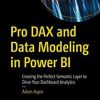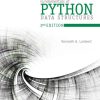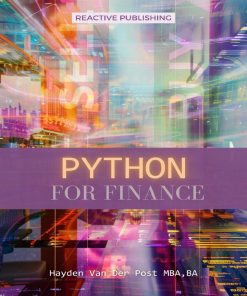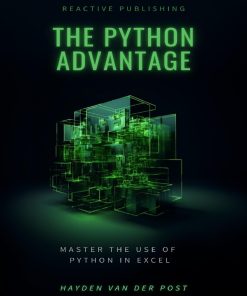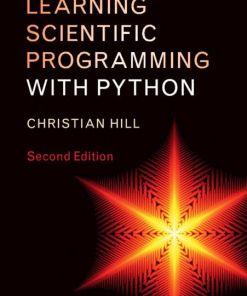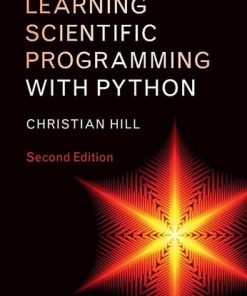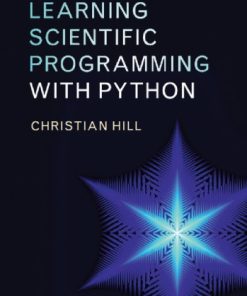Python for Chemists 1st edition by Christian Hill 1009116824 9781009116824
$50.00 Original price was: $50.00.$25.00Current price is: $25.00.
Python for Chemists 1st edition by Christian Hill – Ebook PDF Instant Download/DeliveryISBN: 1009116824, 9781009116824
Full download Python for Chemists 1st edition after payment.
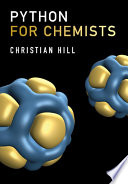
Product details:
ISBN-10 : 1009116824
ISBN-13 : 9781009116824
Author : Christian Hill
This accessible and self-contained guide provides a comprehensive introduction to the popular programming language Python, with a focus on applications in chemistry and chemical physics. Ideally suited to students and researchers of chemistry learning to employ Python for problem-solving in their research, this fast-paced primer first builds a solid foundation in the programming language before progressing to advanced concepts and applications in chemistry. The required syntax and data structures are established, and then applied to solve problems computationally. Popular numerical packages are described in detail, including NumPy, SciPy, Matplotlib, SymPy, and pandas. End of chapter problems are included throughout, with worked solutions available within the book. Additional resources, datasets, and Jupyter Notebooks are provided on a companion website, allowing readers to reinforce their understanding and gain confidence applying their knowledge through a hands-on approach.
Python for Chemists 1st Table of contents:
1 Introduction
1.1 About This Book
1.2 About Python
1.3 Installing Python
1.3.1 Windows
1.3.2 macOS
1.3.3 Linux
1.4 Code Editors
2 Basic Python Usage
2.1 Python as a Calculator
2.2 Defining Numbers
2.3 Variables
2.4 Limitations and Pitfalls
2.5 Examples
2.6 Exercises
3 Strings
3.1 Defining Strings
3.2 String Indexing and Slicing
3.3 String Methods
3.4 String Formatting
3.5 Examples
4 Lists and Loops
4.1 Definitions, Syntax and Usage
4.2 range and enumerate
4.3 Creating lists
4.4 split and join
4.5 zip
4.6 Examples
5 Comparisons and Flow Control
5.1 Comparisons and Logic
5.2 if … elif … else
5.3 while loops
5.4 More Control Flow: break, continue and pass
5.5 Exceptions
5.6 Examples
5.7 Exercises
6 Functions
6.1 Defining Functions
6.2 Keyword and Default Arguments
6.3 Docstrings
6.4 Scope
6.5 lambda (Anonymous) Functions
6.6 Examples
7 Data Structures
7.1 Lists
7.2 Tuples
7.3 Sets
7.4 Dictionaries
7.5 Examples
7.6 Exercises
8 File Input/Output
8.1 Writing Files
8.2 Reading Files
8.3 Character Encoding
8.4 Example
8.5 Exercises
9 Basic NumPy
9.1 Creating NumPy Arrays
9.2 Indexing and Slicing NumPy Arrays
9.3 NumPy Array Aggregation
9.4 NaN: Not a Number
9.5 Boolean Arrays and Indexing
9.6 Reading Data Files into a NumPy Array
9.7 Examples
9.8 Exercises
10 Graph Plotting with Matplotlib
10.1 Line Plots and Scatter Plots
10.2 Examples
10.3 Exercise
11 The Steady-State Approximation
12 Liquid–Vapor Equilibrium
13 Jupyter Notebook
13.1 Jupyter Notebook Basics
13.1.1 Starting the Jupyter Notebook Server
13.1.2 Editing a Jupyter Notebook
13.1.3 Running Cells
Code Cells
13.2 Markdown Cells in Jupyter Notebook
13.2.1 Paragraphs and Headings
13.2.2 Font Styles
13.2.3 Itemized and Enumerated Lists
13.2.4 Links
Automatic Links
Links to Local Files
Literal Text and Code Examples
13.2.5 Tables
13.2.6 Images and Video
14 LaTeX
14.1 Mathematics with LaTeX
14.1.1 Basic Syntax
Commands and Symbols
Whitespace in LaTeX Source
Exponents and Indices
Braces
Font Styles
Fractions
Roots
Sums, Products and Integrals
Brackets
Matrices
Fine-Tuning
Annotating Symbols
14.1.2 Units
14.2 Chemical Equations
14.3 Example
15 Chemistry Databases and File Formats
15.1 Formats
15.1.1 SMILES
15.1.2 XYZ
15.1.3 Molfile
15.1.4 Chemical Markup Language
15.1.5 InChI and InChIKey Identifiers
15.2 Online Services
15.2.1 Wikipedia
15.2.2 ChemSpider
15.2.3 PubChem
15.2.4 NIST
15.3 Example
15.4 Exercises
16 More NumPy and Matplotlib
16.1 NumPy
16.1.1 NumPy Array Manipulation
16.1.2 NumPy Polynomials
16.1.3 NumPy Comparisons
16.2 Physical Constants (SciPy)
16.3 More Matplotlib
16.3.1 Error Bars
16.3.2 Contour Plots and Surface Plots
16.3.3 Multiple Axes
16.4 Example
17 Thermodynamic Cycles
17.1 Internal Energy and the First Law
17.2 Example
17.3 Exercise
18 Vectors, Matrices and Linear Algebra
18.1 NumPy Arrays as Vectors
18.1.1 Vectors and Vector Operations
18.1.2 Column Vectors
18.2 NumPy Arrays as Matrices
18.2.1 Defining Matrices
18.2.2 Matrix Multiplication
18.2.3 Matrix and Vector Multiplication
18.2.4 Broadcasting
18.3 Linear Algebra
18.3.1 Matrix Powers, Determinant and Inverse
Matrix Powers
Determinants and the Matrix Inverse
18.3.2 Eigenvalues and Eigenvectors
18.3.3 Solving a Set of Linear Equations
18.4 Examples
18.5 Exercises
19 Linear Least Squares Fitting I
19.1 Background
19.2 Fitting a Line of Best Fit
19.3 numpy.linalg.lstsq
19.4 Examples
19.5 Exercises
20 Linear Least Squares Fitting II
20.1 Parameter Uncertainties
20.2 Example
20.3 Exercises
21 Numerical Integration
21.1 Integrals of a Single Variable
21.2 Integrals of Two and Three Variables
21.3 Examples
21.4 Exercise
22 Optimization with scipy.optimize
22.1 Multivariate Minimization and Maximization
22.2 Univariate Minimization and Maximization
22.3 Example
22.4 Exercises
23 Vibrational Spectroscopy
23.1 The Harmonic Oscillator Model
23.2 Example
23.3 Exercise
24 The Morse Oscillator
24.1 Example
25 Solving Ordinary Differential Equations
25.1 A Single First-Order ODE
25.2 Coupled First-Order ODEs
25.3 A Single Second-Order ODE
25.4 Example
26 The Oregonator
26.1 Theory and Analysis
26.2 Exercise
27 Root-Finding with scipy.optimize
27.1 Root-Finding Algorithms
27.2 Example
28 Rotational Spectroscopy
28.1 Diatomic Molecules: The Rigid Rotor
28.1.1 Energy Levels of the Rigid Rotor
28.1.2 Rigid Rotor Transitions
28.1.3 Carbon Monoxide and the Rigid Rotor Approximation
28.2 Centrifugal Distortion
28.2.1 Centrifugal Distortion in Hydrogen Iodide
28.3 Polyatomic Molecules
28.3.1 Symmetric Tops
28.3.2 The Rotational Spectrum of Phosphine
29 Peak Finding
29.1 Simple Peak-Finding
29.2 scipy.signal.find_peaks
29.3 Example
30 Fitting the Vibrational Spectrum of CO
30.1 Analyzing a Rovibrational Spectrum
30.2 Fitting the Spectrum
31 pandas
31.1 Series
31.2 DataFrame
31.2.1 Defining a DataFrame
31.2.2 Accessing Rows, Columns, and Cells
31.2.3 Sorting and Statistics
31.3 Reading and Writing Series and DataFrames
31.3.1 Reading Text Files
31.3.2 Writing Text Files
31.4 Examples
31.5 Exercise
32 Simulating a Powder Diffraction Spectrum
33 The Hückel Approximation
33.1 Theory
33.2 Examples
33.3 Exercises
34 Nonlinear Fitting and Constrained Optimization
34.1 scipy.optimize.least_squares
34.2 scipy.optimize.curve_fit
34.3 scipy.optimize.minimize with Constraints
34.4 Examples
34.5 Exercises
35 SymPy
35.1 Algebra and Mathematical Functions
35.1.1 Symbols and Expressions
35.1.2 Simplifying Expressions
35.2 Equation Solving
35.2.1 Single Equations
35.2.2 Linear and Nonlinear Systems of Equations
35.3 Calculus
35.3.1 Differentiation
35.3.2 Integration
35.3.3 Summation
35.3.4 Series Expansion
35.3.5 Differential Equations
35.4 Example
35.5 Exercises
36 Molecular Orbital Theory for H[sup(+)][sub(2)
37 Approximations of the Helium Atom Electronic Energy
37.1 Theory
37.2 Attempt 1: Ignore Electron–Electron Repulsion
37.3 Attempt 2: One-Parameter Variational Approach
37.4 Attempt 3: Hartree–Fock with a Minimal Basis
38 Computational Chemistry with Psi4 and Python
38.1 Installing Psi4
38.2 Examples
38.3 Exercise
39 Atomic Structure
39.1 One-Electron Atoms
39.1.1 Solving the Schrödinger Equation
39.1.2 Radial Wavefunctions and Distribution Functions
39.1.3 Angular Wavefunctions
39.1.4 Atomic Spectra
39.2 Many-Electron Atoms
39.2.1 Effective Nuclear Charge
39.2.2 Ionization Energies and Polarizability
39.2.3 Grotrian Diagrams
40 Solutions
People also search for Python for Chemists 1st:
python for chemists pdf
python for chemists christian hill pdf
python for chemists course
python for chemists book
python for chemists github
Tags: Python, Chemists, Christian Hill, comprehensive introduction, programming language
You may also like…
Children's Books - Mysteries & Detective Stories
Assassinio nella band 1st edition by Christian Hill B0C6648CNN
Comics & Graphic Novels - Children's
Computers - Computers - General & Miscellaneous
Comics & Graphic Novels - Children's
Computers - Programming
Computers - Programming
Learning Scientific Programming With Python 2nd Edition Christian Hill
Computers - Programming
Computers - Programming


